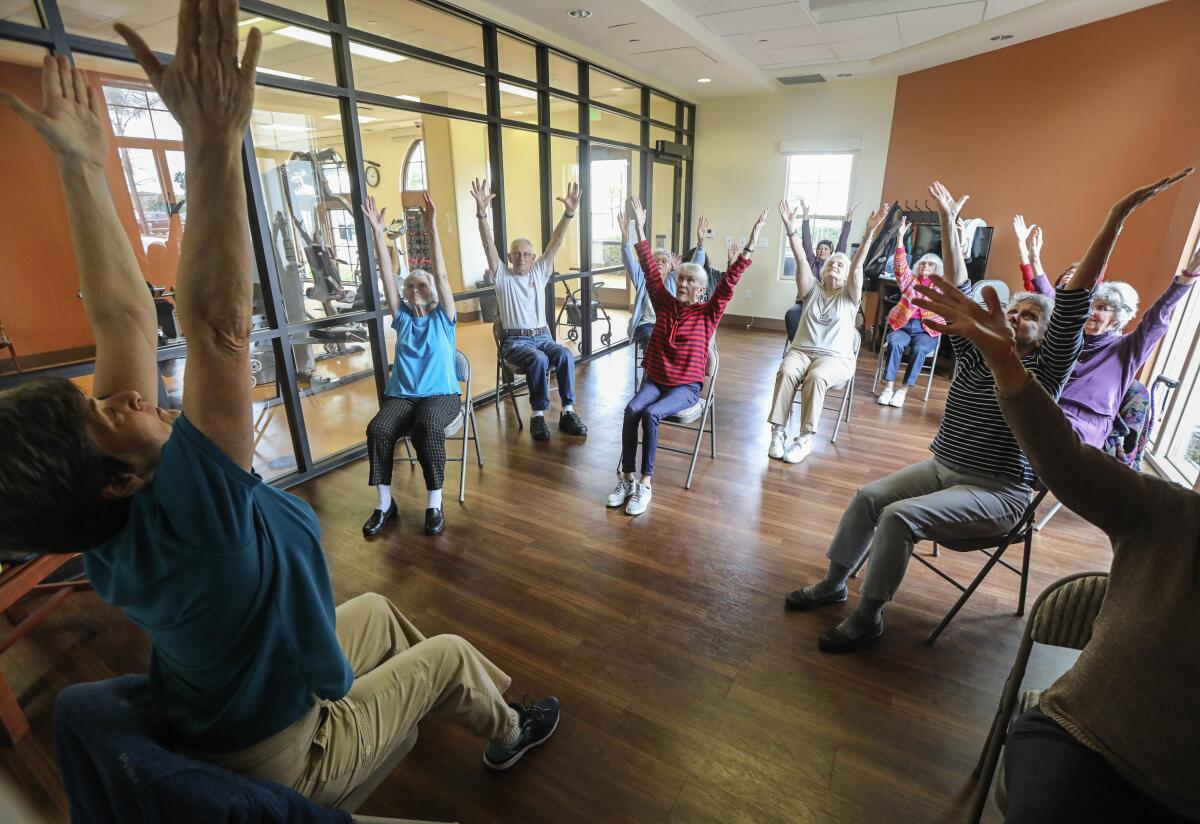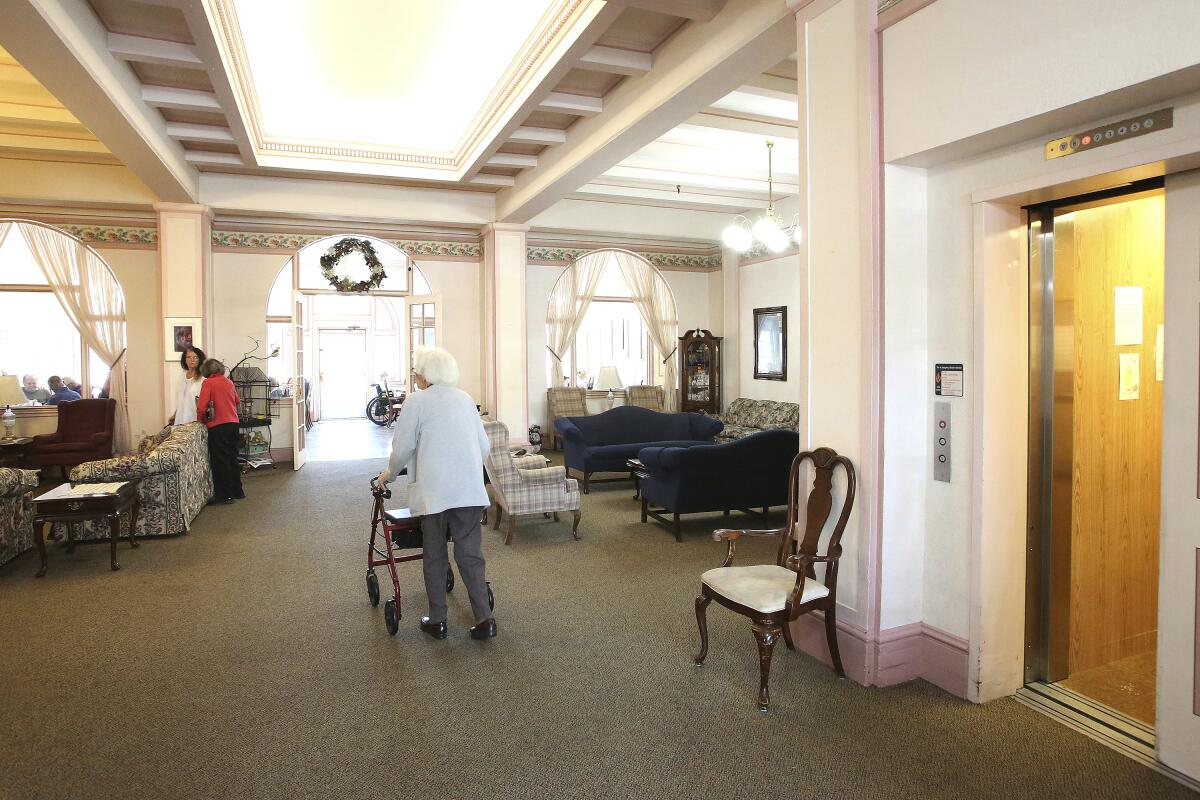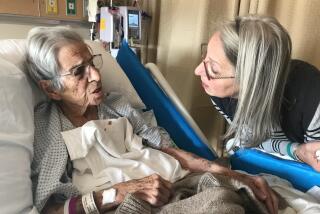Column: As some nursing homes cry poverty, what can be done about increased staffing requirements?

- Share via
If you suspect that you or a loved one might one day end up in a nursing home, and you breathed a sigh of relief when the Biden administration announced increased staffing requirements on April 22, you may need to pull a Larry David and curb your enthusiasm.
Biden’s follow-through on an earlier promise was applauded by many, given the dark history of substandard care and chronic staffing shortages that have led to unconscionable levels of suffering and even death. But will the nursing home industry actually do the hiring, or repeat the refrains that it can’t afford to without higher government reimbursement rates, or that it can’t find enough new employees?
It didn’t take long for the protesting to begin.
California is about to be hit by an aging population wave, and Steve Lopez is riding it. His column focuses on the blessings and burdens of advancing age — and how some folks are challenging the stigma associated with older adults.
Mark Parkinson, president and CEO of a healthcare association representing 14,000 nursing homes, slammed the Biden administration for imposing “this unfunded staffing mandate despite overwhelming concerns from experts, stakeholders, and policymakers on both sides of the aisle.”
Then came the doomsday prediction, with Parkinson claiming the mandate “threatens to shut down more nursing homes, displace hundreds of thousands of residents, and restrict seniors’ access to care.”
That’s an interesting perspective, given the fact that while the hiring pool may be too small, there’s no shortage of investors lining up for a piece of the profits generated by nursing homes. Profits that are filtered, if not shielded, using elaborate financing schemes.
(In March, KFF Health News reported that “for-profit groups own about 72% of the roughly 15,000 nursing homes in the United States, which serve more than 1.3 million residents.” In addition, “900 not-for-profit nursing homes and senior living communities nationwide have changed hands [since 2015], with more than half of them acquired by for-profit operators.”)
I asked David Grabowski, a Harvard University professor of healthcare policy, for his take on the Biden administration’s new rules.
“The minimum staffing rule is an important step forward. However, for this rule to work, it can’t be implemented in a vacuum,” Grabowski responded in an email. “If nursing homes are unable to hire additional workers, we need to understand if this is because they can’t afford to due to low Medicaid payments or because they are hiding profits in related party transactions.”
And that would require, in Grabowski’s opinion, “stronger data transparency and accountability measures” from the Biden administration.
But let’s get back to the “hiding profits” reference.

Getting old, as we’re now doing like never before thanks to the age wave, is big money if you know where to lay your bets. And investors, including venture capitalists, private equity firms and real estate interests, have flocked like gold diggers, panning for the billions in taxpayer dollars paid to nursing homes each year by Medicare and Medicaid.
Nursing home operators often have multiple related companies that do business with one another , said Ashvin Gandhi, a professor and faculty associate at the UCLA Center for Health Policy Research, and they sometimes use “tunneling” practices to obscure true profitability.
By way of explanation, he told me a nursing home might sell its building and land to a sister company, and then pay inflated rent to that company. Or it might contract with another sister company for management services and pay inflated rates. The same can be done with food services, say, or laundry services.
It’s a creative way to hide profits by shifting assets to businesses that are less regulated than the healthcare industry, and, at the same time, build an argument against government interference.
Too bad the nursing home operators seem to be unable to summon the same energy and creativity to lower the number of nursing home deaths associated with pressure ulcers, also known as bedsores: The Department of Health and Human Services estimates that “about 60,000 patients die as a direct result of a pressure ulcer each year.”
“Masking profits as costs, thereby obscuring true profitability, may dissuade regulators from imposing stricter quality standards and encourage public payers to increase reimbursement rates,” says a recent study by Gandhi and Andrew Olenski, an assistant professor of economics at Lehigh University.
“Our estimates suggest that in 2019, 63% of nursing home profits were hidden and tunneled to related parties through inflated transfer prices,” the study says.
And that’s money that could be used to increase staffing and raise pay high enough to recruit new employees.
In the case of Sam Rios, a former Sacramento State professor who died with complications from pressure sores after a stay in a Roseville nursing home, attorney Ed Dudensing didn’t just sue the nursing home. He sued its partner companies, including a private equity firm, arguing that the conglomerate was highly profitable and paid high salaries to executives while nursing home patients were jeopardized by understaffing.
A jury agreed, awarding $5.9 million in compensatory damages and $25 million in punitive damages early last year. Dudensing told me the cry of poverty in the nursing home industry is easily debunked by the fact that “private equity money, venture capital” and other investments “are still flowing into these facilities at record rates … and balance sheets are very easy to manipulate.”
The Biden order, introduced by Vice President Kamala Harris, was two-pronged, including a plan for easier access to in-home elder care and better workforce pay. I’ll save that aspect for another column, because as I’ve already reported, in one of the great unanswered crises of our time, millions of people either can’t find care as they age, or they can’t afford it, or they go broke paying for it.
But getting back to staffing, the new order requires facilities that receive federal funding to provide nearly 3.5 hours of nursing per patient per day, roughly one half-hour of RN coverage and roughly 2.5 hours of nursing aide coverage. And an RN must be on duty 24 hours a day.
California already has a 3.5-hour requirement in place, but the RN requirements will be an improvement, said Tony Chicotel, senior staff attorney at California Advocates for Nursing Home Reform. But he added a critical caveat.
“The main thing California can do is enforce the standard,” he said. “We have publicly available data through which we can identify facilities that are chronically understaffed but nothing happens to them. ... There has never been any push to enforce our state standard, so compliance has always been spotty.”
Speaking of lack of urgency, patient advocates in L.A. County — the only county in California with its own enforcement arm — are still awaiting a long overdue report from a consultant hired to analyze oversight and enforcement lapses that were identified during the pandemic, when more than 3,600 patients and staffers suffered COVID-related deaths.
I attended a Jan. 29 forum hosted by L.A. County Supervisor Kathryn Barger in which patient advocates railed against the delays and were told by a Department of Public Health official that the $349,455 study—first recommended in late 2021— would be completed soon. Nearly three months later, it’s still not done, and Barger’s staff tells me it appears it will take another two months for the report to be completed and publicly aired.
Molly Davies, president and CEO of Wise & Health Aging, called the delay unsurprising and upsetting, saying that after all the public interest in nursing homes during the epidemic of pandemic deaths, residents “have been orphaned” yet again.
“Folks that live in skilled nursing need a champion to take on this powerful industry and improve regulatory enforcement and oversight,” said Davies, whose nonprofit sends ombudsmen into L.A. County nursing homes to monitor conditions and investigate complaints.
Her agency, by the way, is understaffed and underfunded in that regard. Davies said she fears that efforts to free more state funding for such efforts appears to be a long shot, given budget deficits.
The county health department needs to pick up the pace, and Barger and other supervisors need to shake a stick both at the county and state level.
Hardworking underpaid employees, along with the elderly, disabled, sick and frail, deserve nothing less.
More to Read
Sign up for Essential California
The most important California stories and recommendations in your inbox every morning.
You may occasionally receive promotional content from the Los Angeles Times.










